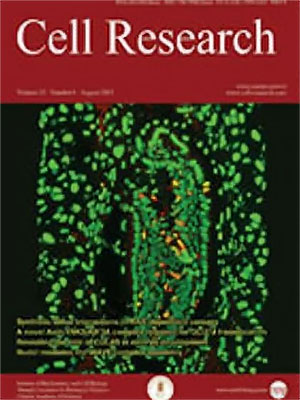
Volume 13, No 5, Oct 2003
ISSN: 1001-0602
EISSN: 1748-7838 2018
impact factor 17.848*
(Clarivate Analytics, 2019)
Volume 13 Issue 5, October 2003: 385-391
ORIGINAL ARTICLES
Intermittent hypoxia attenuates ischemia/reperfusion induced apoptosis in cardiac myocytes via regulating Bcl-2/Bax expression
JIAN WEN DONG1, HAI FENG ZHU1, WEI ZHONG ZHU1, HAI LEI DING1, TIE MIN MA2, ZHAO NIAN ZHOU1*
1Laboratory of Hypoxic Cardiovascular Physiology, Shanghai Institutes for Biological Sciences,Chinese Academy of Sciences, Shanghai 200031, China. E-mail: znzhou@server.shcnc.ac.cn
2Department of Physiology and Pathophysiology, Health Science Center Peking University, Beijing 100083, China.
Correspondence: Zhao Nian ZHOU(znzhou@server.shcnc.ac.cn )
Intermittent hypoxia has been shown to provide myocardial protection against ishemia/reperfusion-induced injury. Cardiac myocyte loss through apoptosis has been reported in ischemia/reperfusion injury. Our aim was to investigate whether intermittent hypoxia could attenuate ischemia/reperfusion-induced apoptosis in cardiac myocytes and its potential mechanisms. Adult male Sprague-Dawley rats were exposed to hypoxia simulated 5000 m in a hypobaric chamber for 6 h/day, lasting 42 days. Normoxia group rats were kept under normoxic conditions. Isolated perfused hearts from both groups were subjected to 30 min of global ischemia followed by 60 min reperfusion. Incidence of apoptosis in cardiac myocytes was determined by terminal deoxynucleotidyl transferase mediated dUTP nick end labeling (TUNEL) and DNA agarose gel electrophoresis. Expressions of apoptosis related proteins, Bax and Bcl-2, in cytosolic and membrane fraction were detected by Western Blotting. After ischemia/reperfusion, enhanced recovery of cardiac function was observed in intermittent hypoxia hearts compared with normoxia group. Ischemia/reperfusion-induced apoptosis, as evidenced by TUNEL-positive nuclei and DNA fragmentation, was significantly reduced in intermittent hypoxia group compared with normoxia group. After ischemia/reperfusion, expression of Bax in both cytosolic and membrane fractions was decreased in intermittent hypoxia hearts compared with normoxia group. Although ischemia/reperfusion did not induce changes in the level of Bcl-2 expression in cytosolic fraction between intermittent hypoxia and normoxia groups, the expression of Bcl-2 in membrane fraction was upregulated in intermittent hypoxia group compared with normoxia group. These results indicated that the cardioprotection of intermittent hypoxia against ischemia/reperfusion injury appears to be in part due to reduce myocardial apoptosis. Intermittent hypoxia attenuated ischemia/reperfusion-induced apoptosis via increasing the ratio of Bcl-2/Bax, especially in membrane fraction.
FULL TEXT | PDF
Browse 2175


